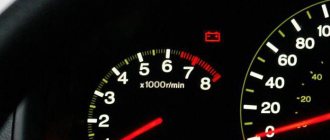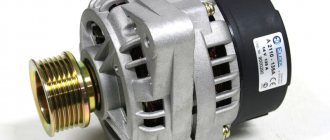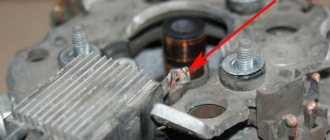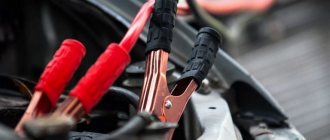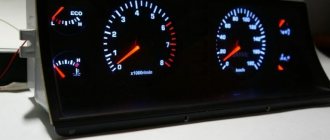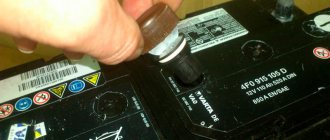Surely every car owner has encountered a situation where a dead battery could not start the engine. In this article, we will give useful tips and show you how to charge your car battery yourself, without the help of special services.
There are a number of reasons why a battery may be discharged. The most common is wear and tear. More than five years is considered a good life cycle for her. However, over time, the ability to hold a charge decreases, and after 3-4 years, car owners may encounter the problem of a dead battery.
There are other reasons for battery drain
:
- short trips that do not allow it to fully charge;
- use of on-board electronic devices during downtime;
- interior lighting left on overnight, dimensions turned on;
- extreme temperatures;
- Installing the wrong battery that does not meet the vehicle's requirements.
Battery charging time may vary depending on the manufacturer, capacity, amplifiers and charger used.
This step-by-step guide will allow you to safely and efficiently charge your battery without outside help. It should be understood that it is strictly forbidden to recharge damaged batteries.
How to charge a battery at home
Step 1.
Make sure your charger is suitable for your specific battery. If it is an AGM or EFB battery, you will need a digital charger.
Step 2.
Clean lead contacts. If they look dirty or corroded, scrub them with a wire brush and remove any remaining debris before connecting the charger.
Check that the liquid inside covers the plates (you may need to add distillate if necessary). This will increase battery life and reduce the risk of excessive off-gassing and bubble formation.
Step 3.
Before disconnecting the battery, as a precaution, make sure you have the PIN codes for the electrical components: navigation system, radio, etc. on hand, as they may need to be reset when reconnected.
Step 4.
It is important to disconnect the negative lead first to prevent electric shock and connect it last. Loosen the clamps or screws that connect the battery to the terminals and remove the retaining mechanism that holds the battery in its case. Be careful not to leak when handling and moving the battery to the charging location.
Step 5.
With the battery placed on a stable, flat surface, connect the charger cables to the battery, matching the positive and negative values.
Once they are secured, connect the charger to the mains. Make sure the battery and charger are as far away from each other as possible.
Step 6.
Before turning on the power for charging, please read the manual that came with the charger. Check whether you need to turn it off manually or whether it will automatically turn off when the charging cycle is complete (this depends on the model, manufacturer).
How to prepare a battery for charging
To avoid getting an electric shock when removing the battery, make sure that everything is de-energized (this applies to headlights, interior lighting, etc.).
Once you get to the battery, first remove the negative, or ground, cable. It is always painted black. On the top of the battery there are marks with poles: the grounding cable is marked with a negative sign (-), and the power cable, or positive, has a mark (+).
Clean the terminals using a brush and a mixture of baking soda and water to neutralize the acid.
What will you need to charge the battery?
You will need a straightener. This is a device that converts alternating current into direct current. There are portable and transformer models.
If trouble happens on the road and there is no way to use a special charging device, other methods can come to the rescue:
- charge from the cigarette lighter;
- starter;
- use of a donor car.
Features of car battery charging
If battery cells are significantly oxidized, wear safety glasses and a mask to prevent airborne corrosion from entering your eyes, nose, and mouth.
If the battery has removable caps, carefully remove them and check the water level. If there is not enough liquid in any of the cells, add distilled water. Care must be taken here not to overfill the container. Most batteries today do not require maintenance, so opening them for this purpose will not work.
Rules for charging a car battery
- Make sure the charger is turned off.
- Connect the positive charger cable to the positive terminal on the battery.
- Connect the negative cable on the charger to the negative terminal.
- Set the charger to the minimum charging intensity.
- Turn on the charger and set the timer.
- When removing the charger, first de-energize it, remove the positive cable, and then the negative cable.
Reasons for battery drain
There are several such reasons, some of which were touched upon in the article about generator repair. So this:
- weak alternator belt;
- The battery terminals are oxidized; how to clean them has already been written;
- generator is faulty;
- frequent, short trips;
- The charging relay is faulty; on some older “classic” models it is located separately from the generator.
Types of chargers for charging the battery
There are models for charging a car in the garage or at home. And there is a portable type - an emergency starter, which allows you to start the engine in emergency situations.
Chargers can be manual or automatic. Fully automatic devices determine the degree of battery discharge and independently switch to maintenance mode to protect it from overcharging. According to their purpose, such devices are classified into three groups:
- chargers;
- starting-charging;
- launchers.
A typical home charger consists of a simple transformer and rectifier to convert high voltage AC to 12V.
Basic home chargers will provide an output of 3 to 6 amps when charging a battery that is in fairly good condition. Other models also feature advanced automatic charging features and safety systems to prevent overcharging. They are divided into pulse and transformer.
The pulse device is lightweight and small. It is equipped with an inverter and automatic short circuit protection. This is a more modern and simpler way to recharge batteries at home. Therefore, when considering the option of purchasing such a device, it is better to give preference to the pulse variety.
The transformer type is more bulky and heavier, since it is equipped with a rectifier and transformer.
If the battery is in good condition, the charging speed can be from 3 to 6 amps using a regular home charger. Once the battery expires, it may not hold a charge at all.
Some devices are equipped with a Hi-Low switch to select two charging speeds—usually 3 or 6 amps. If you want to charge the battery in a short time, you will need 6 amps, for a longer charge - 3 amps.
Many modern models are equipped with a charge indicator - a signal lamp or sign showing the charge level in amperes.
Battery charging process
The sequence of charging steps is as follows:
- Turn off the car.
- Make sure the charger is turned off and disconnected.
- Connect the red clamp to the positive terminal.
- Connect the black clamp to grounded metal, the vehicle frame, or engine block.
- Once both clamps are connected, plug the charger into the outlet.
- Turn on the car battery charger.
- The battery will begin to charge. Leave the charger overnight.
- In the morning we turn off the charger.
- Turn on the machine to see if it works.
- If the car still won't start, you may need to replace the battery.
Self-charging battery
Of course, you can take a dead battery to a service center, but you can charge it yourself, and you don’t need to be a specialist. So, we’ll tell you how to charge your battery at home. The main thing here is to follow safety precautions, so use glasses, chemical-resistant gloves, a working charger, and do not turn the battery on its side or upside down, pay attention to the polarity when connecting the charger! You need to work in a ventilated area, without the presence of open flame.
First, evaluate the color and condition of the electrolyte - by disconnecting the battery from the terminals and removing the covers, look at the color of the “liquid” inside. If it is transparent, then everything is in order, but dregs, and especially floating flakes, can signal a short circuit, and then you will have to change the battery. If everything is fine, then you can start.
There are three charging options, and we will tell you about them all now:
Using DC
This method will require maximum control and regular adjustment of the amperage every 1.5 - 2 hours, as well as the density of the electrolyte.
For example, in order to properly charge a battery with a capacity of 55 or 60 A, you will have to keep the battery connected to the charger at a current of 5.5 - 6 amperes for ten hours. This value of 1/10 (0.1) is taken based on the capacity. For the “sixty” it is equal to - 60 * 0.1 = 6A
With a current of 3 A (multiplier 0.05), you need to charge for 20 hours.
Charging stops when the required density is reached, the battery voltage is 16 volts or the charging current does not decrease within 2 hours.
Constant pressure
More modern chargers are used and the convenience of this method is that you do not need to think about how long to charge the car battery - as soon as the charge is full, the indicator will light up and the charger can be turned off.
Combined method
Here everything is even simpler, first the battery is charged with direct current, and then with voltage. This is the principle on which most modern chargers work. That is, human intervention is required here only for connecting and plugging into the network, and then the charger with automatic shutdown will do all the work itself. For example, the Vympel-30 charger is designed for charging various batteries, however, it has different modes.
Automatic charger "Vympel 30"
"Ambulance"
Sometimes you need to recharge the battery as quickly as possible. In this case, you need to set the current to 12 - 15 A and charge the battery for 20 minutes, which will be enough to start the car. But remember that such express charging will not work if the battery is half discharged or more. And yet, you should not resort to this method very often, this will negatively affect the longevity of the battery.
There is one peculiarity in how to charge a completely discharged car battery. The fact is that modern chargers are protected against short circuits and operate only when there is a reverse voltage of at least 8 volts. A “dead” battery cannot provide it, therefore, we connect the charger to the battery, and then for 1-2 seconds, observing the polarity, we connect any other charged battery to the circuit. We remove the “launcher” and then proceed according to the standard scheme.
Some chargers can be used to assist the battery during engine starting and are called “Starting Chargers”. When the battery is dead or in winter, they are connected to the car battery, turned on and starting the car.
In the old days I came across a starter charger “Electronics ZP 01”. Here
of this device.
How to properly charge a maintenance-free battery
Everyone knows that the battery is recharged while the car is moving. This is why manufacturers do not recommend leaving machines turned off for long periods of time. But how to properly charge a maintenance-free battery?
Firstly, even if the battery is not in use, it must be charged periodically to extend its life cycle. The principle itself is similar to the process of charging serviced devices. Only here you need to control the charge voltage. It should be no more than 14.4 volts (unless otherwise specified in the manufacturer’s technical data sheet). Otherwise, the electrolyte level will decrease, which will lead to an increase in its density. Unlike a working battery, water cannot be added to an unused battery.
What happens if you charge with less current?
A small charge proportionally increases the recovery time of the battery capacity. In some cases, it is not possible to charge with the required current. Most non-professional chargers are designed with a maximum rating of 5 Amps. A battery with a capacity of 100 Amp-hours will take 20 hours to charge, that is, a day.
The good news is that small amounts of charge do not harm the battery. On the contrary, there is an ancient method of battery restoration. First, it is charged for a long, long time with a small value of 1 Ampere, then quickly discharged with extra current.
How long does it take to charge a car battery?
The timing is determined by the condition and model of the battery itself and the specifics of your charger. If the battery charge is below 11.85 and the charger is delivering 5 A, a full charge from 400 to 500 cold cranking amps will take about 12 hours. It will take half as much time if the charging speed is 10 amperes. The lower the open circuit voltage in the battery and the colder the amplifiers, the longer it will take to charge.
Battery charging time with direct current
Recharging the battery with the built-in generator may require an hour's drive. Car batteries range from 40 to 110 Ah, and alternators range from 45 to 200 amps.
If you are using a battery charger, a 10 amp device will charge it in 4-11 hours, while a 2 amp charger will take 2-4 days. Of course, you don't need to fully charge the battery to get it running.
Battery charging time with constant voltage
The time largely depends on the battery capacity. How to measure battery capacity? To do this, use a special device - a tester, which allows you to determine this parameter within 15 seconds.
Charging time is 12–16 hours, and for large batteries – up to 2 days. With high charging currents and multi-stage charging methods, this period can be reduced to 8–10 hours, but without a full charge.
After a full charge, the battery should not remain at peak voltage for more than 2 days - it should be reduced to the floating level. This is critical for sealed systems because they are less tolerant of overcharging than flooded systems. Charging beyond the specified values converts excess energy into heat, which in turn leads to boiling of the electrolyte.
How to determine the battery charge level
When fully charged, car batteries should show a voltage of at least 12.6 V. When the engine is running, the indicator varies from 13.7 to 14.7 volts. If you don’t have a multimeter at hand to determine the voltage, you can check with the headlights on. A dim light indicates an insufficient level that is not enough to drive.
If the lights come on when the engine is turned on, it means the alternator is producing some current, but may not be delivering enough power at idle to keep the battery properly charged. During normal charging, the headlights should be uniformly bright.
In addition, you can measure the state of charge by:
- electrolyte density;
- built-in hydrometric indicator;
- voltage at the battery terminals without load.
How to measure battery charge current with a multimeter
Diagnosing a car battery is very simple, but you will need a tool called a multimeter. It will quickly show whether the battery is low or not. But it's better to spend a little more on a digital device to avoid misinterpretation of the readings.
At first glance, a multimeter looks like a tool that only electrical engineers need. But for the experienced professional or hobbyist, it is an indispensable home tool.
Unlike an AC voltage test, which simply tells you that there is electrical current in the wiring, a multimeter can accurately measure voltage and current for many types of electrical circuits. This allows the user to determine the capacitance of a wiring or verify that current is flowing through a circuit in an expected - safe - manner.
The device must be used when the car is turned off. Using a digital tool, set the dial to constant voltage. Next, connect the black lead of the multimeter to the negative terminal of the battery and the red lead to the positive terminal. Hold each one firmly until the multimeter reads voltage.
A reading of 12.45 V or higher indicates the battery is in good condition. Therefore, the cause of the problem must be sought elsewhere. At a charge level of about 75%, the battery will still be able to start the starter, but this indicator is already a signal for recharging. If the multimeter shows a lower reading, the battery needs to be urgently recharged or replaced (depending on its service life).
Symptoms of a dead battery
The battery almost never discharges suddenly, especially since if the electrical equipment is in good working order, the battery is constantly charged from the generator, but sometimes this is not enough. With frequent but short trips, the charge consumption will always be more than the generator can replenish, and sooner or later the charge level will drop to a critical level. Low temperatures can shorten the discharge time, so in the cold season, recharging is needed more often. You can understand in advance that the battery charge is low. Here are the main signs of a dead battery:
- when the ignition is turned on, all indicators go out;
- when the engine is turned off, the car's lighting equipment shines more dimly than usual;
- when you turn the key, you can hear the starter turning several times, but cannot cope with the crankshaft, and loud clicks are heard;
- with a deeper discharge, the starter does not even turn, and the exhaust does not work.
It is worth noting that the cause of all these malfunctions may also be poorly tightened or oxidized terminals.
Checking the battery charge is done with a multimeter or hydrometer; if it shows 12.6-12.8 volts, then the battery is fully charged, if less than 11.8 V, then your battery is completely dead. The hydrometer reading should be 1.27 g/cm3.
Hydrometer for checking electrolyte density
Measuring the voltage value at the terminals without load
This measurement is made at rest. It will only give correct results if at least 6 hours have passed since the last charge.
Each type of device has its own charging rate.
Electrolyte density measurement
To determine the battery charge in this way, you will need a special device - a hydrometer. A modern battery consists of lead plates, lead oxide, and an electrolyte solution. This solution contains 65% water and 35% sulfuric acid.
The specific gravity increases when charging and decreases when discharging. When the battery discharges, the sulfur moves from the solution to the plates. And vice versa: when the battery is charged, the sulfur returns to solution.
Using a load fork
You can find out the charge level by knowing the voltage at the battery outputs under load.
This is done using a voltmeter. For batteries with a capacity of 40–60 Ah, the resistance value should be 0.018–0.020 Ohm.
Measurements are carried out on the battery, completely disconnected from the charger, 5 - 6 seconds after connecting the plug.
Voltage under load of vehicle electrical equipment
You can check the charge level using the side lights. Considering that the average high beam power is 50 W, the load current will be 10 A.
Another way is to turn on the engine and check the charging of the starter. The voltage here, if everything is in order, does not fall below 9.5 V. If this value is less, you need to leave the battery on recharge, since its charge is not enough for normal operation of the machine.
According to the built-in hydrometric indicator
This method is suitable for batteries equipped with a transparent viewing eye. This is a hydrometric indicator that helps determine the battery charge level without additional tools.
The green indicator indicates a charge level of 60%. This is, in principle, enough to stop the charge and use the car.
A dark indicator indicates insufficient charging. A colorless indicator indicates low water level. At such indicators, it is necessary to add distillate.
Can I “light up” from another car?
A common and effective charging method is to “light it” from another car, but only if the starter turns sluggishly. Technically, this process is easy, but neglecting the simplest rules can lead to failure of the engine control unit, BCM units, and so on. Subsequence:
- we connect the wires to the donor battery, first clamp the “+” terminal after the “-” with crocodiles;
- the second end of the wires is connected to the recipient’s battery, in the same sequence, observing polarity, otherwise you and the donor will lose the battery;
- the recipient’s engine starts, it is desirable that the operating speed range is from 1500 to 3500 rpm, after 20 seconds you can disconnect the patient’s wires and try to start the internal combustion engine. Usually this time is quite enough.
Remember, under no circumstances connect to the patient’s battery while the engine is running, otherwise the generator and a number of electrical equipment are more likely to fail.
How often to charge your car battery
If the machine is used regularly and its systems are working properly, the battery will not need to be recharged at all. As a rule, it is needed only if the engine has not been started for a long time (several months). But you need to take into account that as the battery wears out, its capacity decreases and the discharge rate increases.
On average, a battery lasts 5-7 years. The battery will last longer if the machine is used on a daily basis. Extreme temperatures and wear and tear encountered during normal charging and discharging cycles can reduce reserve capacity. When a car is parked for a long time, the battery wears out faster.
Current strength
Current magnitude is the amount of electricity passing through the cross section of a conductor in a given time. With the same battery capacity, the required amount of electricity can be transferred to the starter both in a second and in several minutes, which will not allow starting the engine. Accordingly, the greater the current, the more electricity will be transferred per second of time.
The current strength throughout the circuit may vary. This is due to the influence of ambient temperature, design features, and exposure to electromagnetic rays from external sources.
Safety precautions when charging the battery
Care must be taken when handling lead-acid batteries. If done incorrectly, the electrolyte in the starter battery may leak or splash out.
Overcharging may result in the formation of explosive hydrogen gas. If your older vehicle is not equipped with a maintenance free battery, a visit to a workshop is recommended.
The charger is charged from AC power and provides a 12V DC output at relatively low voltages, which is the best way to charge a completely discharged battery.
Charging the battery at an excessively high voltage may increase hydrogen production. And this is already a dangerous situation with the subsequent possibility of an explosion.
Regardless, you should wear safety glasses and gloves when servicing, removing, or installing the battery. To prevent short circuits, it is important to avoid connecting terminals in contact with metal or conductive materials, otherwise there is a risk of electric shock or injury.
Why is it important to set the charge current correctly?
The battery charging current is a defining characteristic of the charging mode. In the generalized case, it is the concept of charge “mode” that should be considered. Several types of batteries are used in cars with internal combustion engines:
- Acidic (antimony, calcium, etc.);
- AGM batteries;
- Gel.
Each of these types requires its own charging mode. For example, an AGM battery is fully charged in three stages:
- Main charge.
- Recharge.
- Final charge and preservation.
A conventional battery is charged in a single-stage mode. Deviation of values from standard values can lead to:
- reducing the effectiveness of the operation;
- loss of consumer characteristics;
- destruction of the battery.



